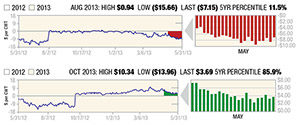 Meanwhile, despite strength in beef prices with the choice cutout reaching record levels this spring, the cattle market has been under pressure with futures in steady decline since the beginning of the year.
Meanwhile, despite strength in beef prices with the choice cutout reaching record levels this spring, the cattle market has been under pressure with futures in steady decline since the beginning of the year.
Against this backdrop, forward margins remain quite strong with the December  and February marketing periods in particular reflecting margins that are either at or well above the 90th percentile of the previous 10 years.
and February marketing periods in particular reflecting margins that are either at or well above the 90th percentile of the previous 10 years.
While the October marketing period currently reflects a profit margin at the 85th percentile, it too was well into the top decile of historical profitability as recently as early May.
 The figures reflect current beef cattle margins as well as comparison graphs to those same profit margins three months ago.
The figures reflect current beef cattle margins as well as comparison graphs to those same profit margins three months ago.
On the feed side of the equation, the corn market continues to be a tale of two seasons.
The old-crop season, which is finishing up as we head into the summer, features declining inventories and a historically tight balance sheet.
Cash-basis premiums have been quite strong all through the winter and spring as it has taken aggressive bids to pry loose stored grain on the farm. The futures market is currently reflecting over $1 inverse between old-crop and new-crop contracts, and this does not even include the positive basis in the spot market.
The new-crop outlook, meanwhile, reflects a much different reality that is expected to set in this fall. USDA released their first balance sheet for the 2013-2014 crop year in the recent May WASDE, and the general theme is one of larger supplies and lower prices.
Ending stocks are expected to grow from 759 million bushels in the current season to 2.004 billion next year, with the stocks-use ratio increasing from 6.8 percent to 15.5 percent in USDA’s initial forecast.
Most of this increase is expected to come from a large crop currently estimated at 14.14 billion bushels, up 3.36 billion from the drought-ravaged crop this past summer.
Although there is some uncertainty regarding actual acreage given the delayed spring planting, early crop conditions would suggest that a trendline yield is still in the cards should the weather cooperate over the summer.
While USDA also raised their forecasted usage in light of the increased supply, it will come as a function of much lower prices. The average farm price was pegged in a range of $4.30-$5.10 per bushel, down from $6.70-$7.10 in the current season.
On the revenue side, while there generally has been strength in beef prices based on the choice cutout, that strength has not extended to all cuts in the beef primal or the select market.
Middle meats or steaks have generally been carrying the cutout value heading into the Memorial Day holiday, but that support typically fades as domestic consumers opt for cheaper alternatives, such as burgers, as the summer heats up.
Hopefully, that grilling demand will help prop up the market as support from higher-value cuts begins to fade. Lean boneless beef prices have been struggling to get much seasonal traction, and the USDA April cold storage report showed total boneless beef stocks at 459.8 million pounds, which was up 3.2 percent from last year and 25.2 percent above the five-year average.
The live cattle futures market is clearly pricing in an expectation for a decline in cutout values from current spot prices, and it may very well prove to be the case that lower prices will be necessary to stimulate additional demand volume going forward.
The need for improved demand seems especially important given that production does not appear to be declining as one might have expected given the shrinking beef cattle herd.
April cattle slaughter totaled 2.729 million head, up 6.2 percent from last year with average weekday slaughter 1.4 percent higher than a year ago. The figure was the largest weekday slaughter increase since June 2011, driven by more cows coming to market than a year ago.
Daily steer-heifer slaughter during the month of April was actually 0.9 percent lower than last year, while cow slaughter was 11.5 percent higher than 2012, the largest increase in daily cow slaughter since September 2011.
The combination of continued poor pasture conditions pushing more cattle on feed and negative dairy margins during the first quarter helps explain the increase in cow slaughter this spring.
In addition to the larger numbers, cattle weights have also been showing year-over-year gains, although the pace of this increase is slowing down.
The average steer carcass weight during the month of April was 844 pounds, up 1.1 percent from last year. Steer-dressed weights averaged 1.7 percent above a year ago during Q1, and in Q4 of 2012 steer weights were 2.6 percent above 2011.
While the declining trend of fat cattle prices is no doubt cause for concern among feedlot managers finishing cattle, forward margins continue to hold up quite well in deferred periods.
Although a second consecutive year of drought is highly unlikely and there currently is no sign of adverse weather in NOAA long-range forecast maps, it is important to remember that much of the reason for the favorable margin outlook stems from expectations for lower feed costs.
The corn crop is obviously a long way from being made and much can happen between now and harvest, so it is prudent to consider ways of managing this price now.
The futures market is already discounting the expectation for larger supplies coming to market, and while prices can certainly move lower later in the year, there are ways to allow for lower prices to be realized over time while still protecting the risk of a higher market.
At the same time, the lower trend in cattle prices may discourage a feedlot from selling forward, yet given that feeder cattle prices have also been declining, it may be prudent to consider the price of fat cattle in a deferred period within the context of the reduced feeder cost nearby.
Again, there are strategies that can be employed which will allow for higher fat values to be realized while still protecting the risk of the market moving lower over time.
In the bigger picture, the profit margin outlook remains favorable for future marketing periods, and there are many different strategies a feedlot can consider to manage these forward margins today. ![]()
Chip Whalen is a senior risk manager and director of education for Commodity & Ingredient Hedging based in Chicago, Illinois.
Chip Whalen
Vice-President Education and Research
CIH – Commodities & Ingredient Hedging LLC










